ASUS Transformer Book T100 Review: Redefining the Entry-Level Windows Notebook
by Anand Lal Shimpi on October 18, 2013 12:00 AM ESTCPU Performance
The Atom Z3740 in the T100 features a 9% lower base clock and 22.5% lower max turbo frequency than the Z3770 we previewed back at IDF. Given how good of a job Bay Trail does turboing up to max frequencies under normal use, I’d expect proportionally lower scores in our tests.
I’ll start with our cross platform browser based benchmarks before moving on to a look at the Z3740 vs. Z3770.
Note for all of these benchmarks I’ve used Google’s Chrome browser. IE11 integrates well into the modern UI of Windows 8.1 but is otherwise a pretty terrible browser by comparison. I think the modern UI Chrome experience on 8.1 isn’t as good, but it’s a better/faster/less-finicky option. Out of all of our tests only SunSpider seems to run quicker under IE11, whereas Chrome wins everywhere else. I think it’s a bit insane to switch between browsers based on the benchmark being run, so we’re sticking with Chrome across the board.
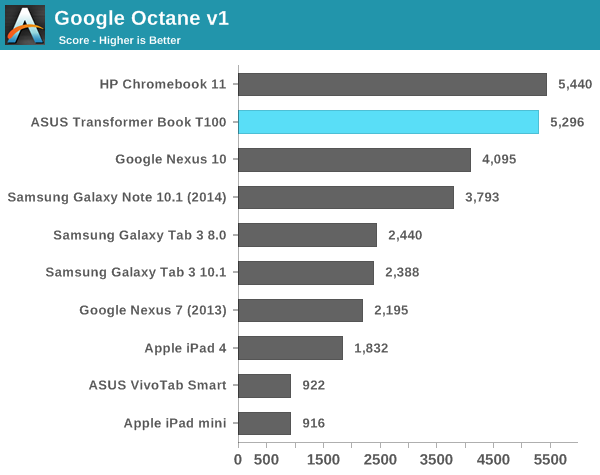
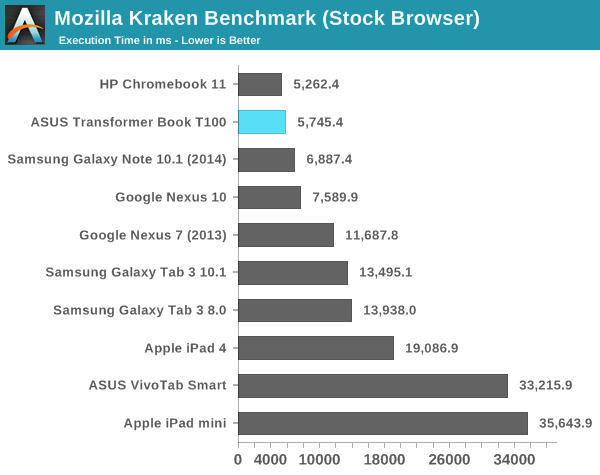
Lightly threaded performance is actually quite comparable to the Chromebook 11, which was a bit surprising. Throw a multitasking workload at the two notebooks and you'll separate the boys from the men though:
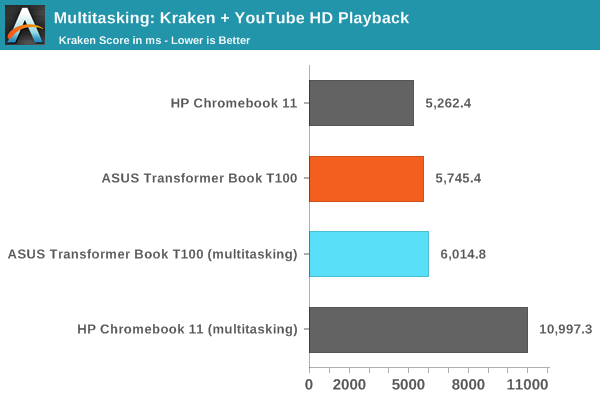
Chrome under Chrome OS performs extremely well for obvious reasons. But here the T100's additional cores and solid memory interface really come in handy when multitasking, there's hardly any performance penalty for this sort of multitasking on Bay Trail while the dual-core Cortex A15 based Chromebook needs serious help.

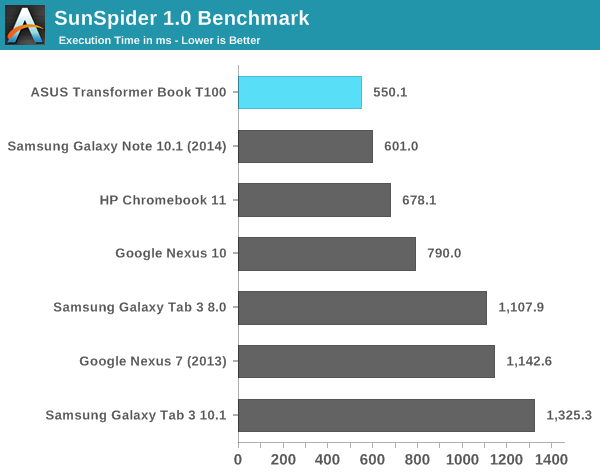
The T100 remains extremely competitive compared to the Chromebook 11 and definitely compared to Android tablets.
Next up is putting the Atom Z3740's performance in perspective compared to our earlier FFRD data:

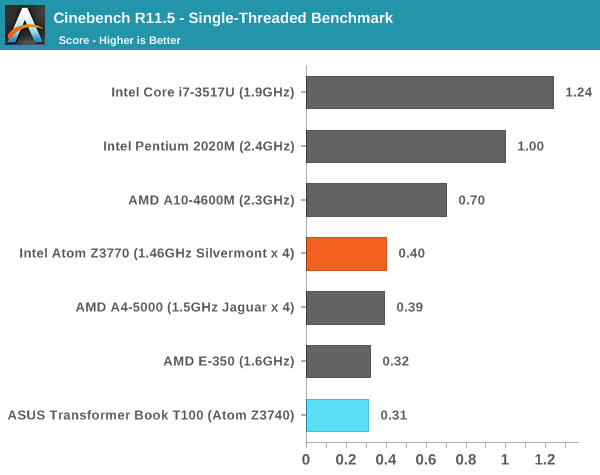


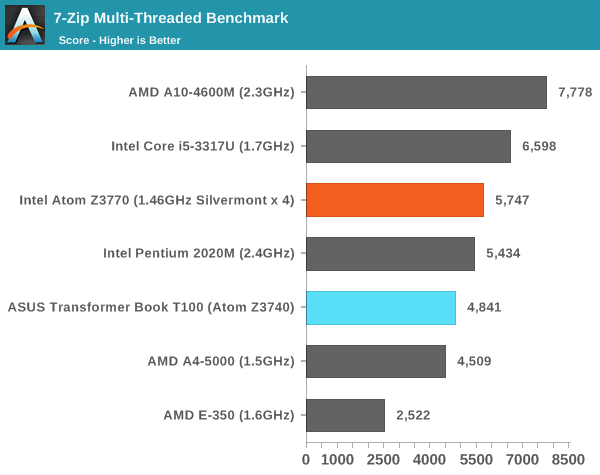
In all of these tests we see nearly perfect scaling compared to the Atom Z3770. Turbo frequencies are regularly hit when under load, and as a result see see proportionally lower performance from the T100. I would’ve liked to have seen the Z3770 used in the T100, but not if it meant a higher price, an optional dock or a worse display.
GPU Performance
I didn’t have a ton of time to go through gaming performance on the T100, but with a quarter of the EUs of Ivy Bridge it’s clear that you shouldn’t expect a GPU monster out of Bay Trail. In our cross platform graphics tests however the T100 is quite competitive, although not industry leading by any means.
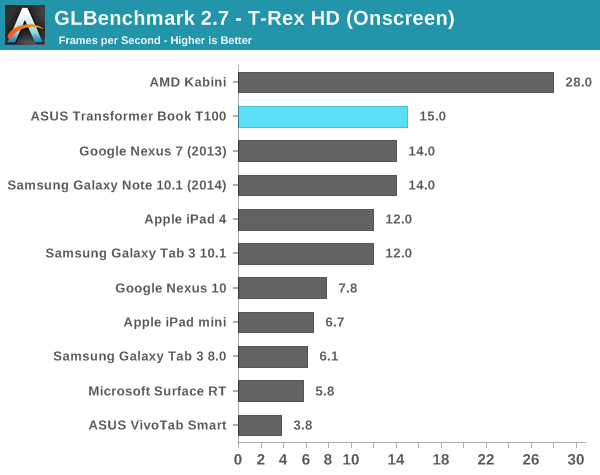
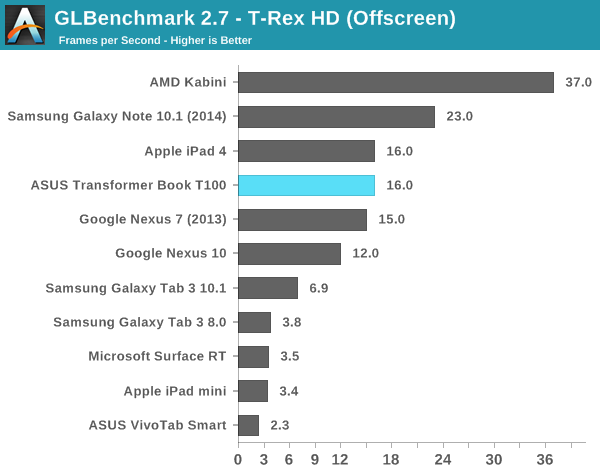
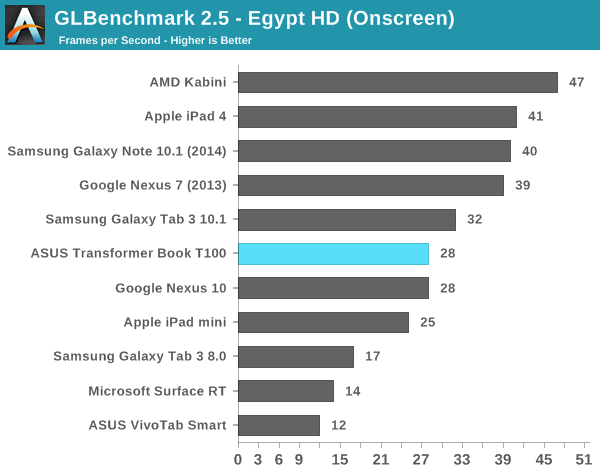
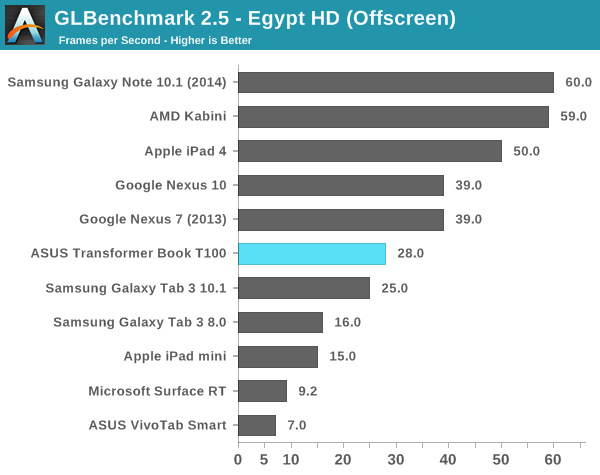
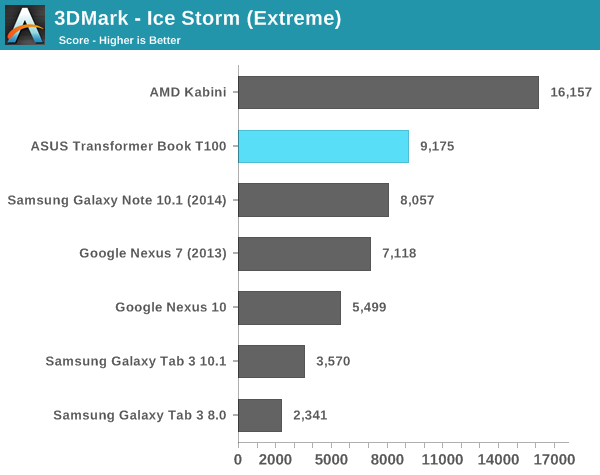

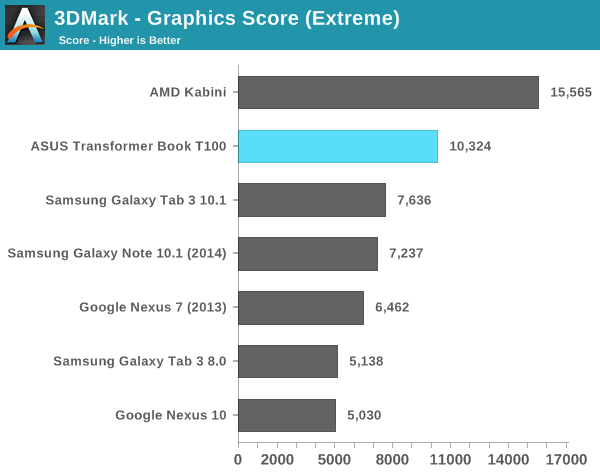
I did see some choppy animations at times and indications that the GPU (or its drivers) weren’t up to snuff, but that’s exclusively in classic desktop mode. In the modern UI, the Atom Z3740 was very smooth.
Storage Performance
Our Android IO tests rely on Androbench with a relatively limited LBA span. I increased the difficulty of the test a bit under Windows 8.1 but still kept it reasonable since we are dealing with eMMC solutions. I’m testing across a 1GB LBA span and testing for a period of 1 minute, which is an ok balance between difficulty of workload and sensitivity to the fact that we’re evaluating low-class SSDs here.
Sequential read and write performance is competitive with the high-end examples we’ve seen in the Android space. Random read performance is similarly good, while random write performance is appreciably better than what we’re used to in Android tablets. It is good to see ASUS/Intel/Microsoft concerned about random write performance, but I’d still like to see a 5 - 10x increase in these numbers with a focus on sustained performance before I’m truly happy.
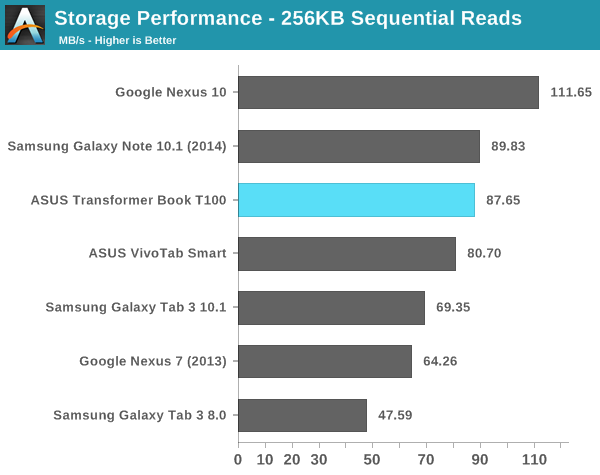
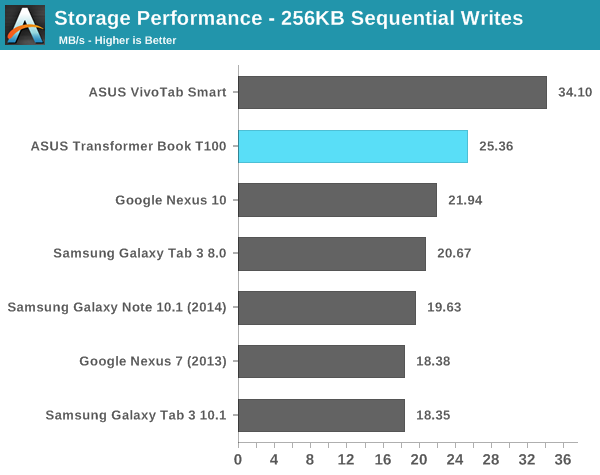
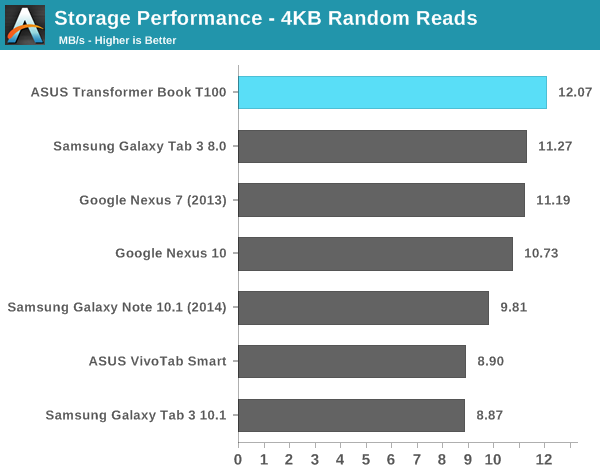
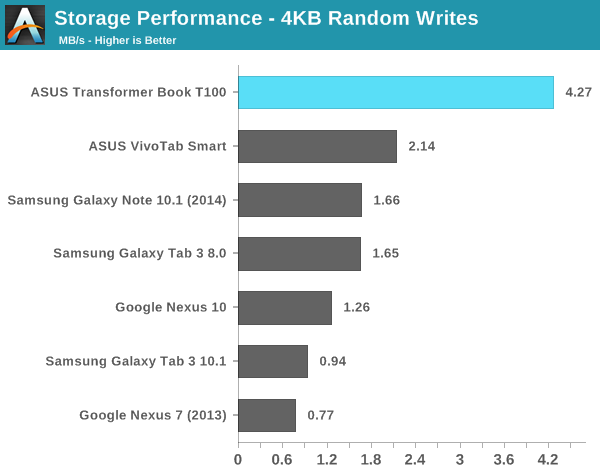










158 Comments
View All Comments
damianrobertjones - Sunday, October 20, 2013 - link
I cannot believe how many times the HP Chromebook 11 is mentioned in this article! It's being pushed onto the consumer HARD.azazel1024 - Sunday, October 20, 2013 - link
Can anyone confirm if the micro USB port on the tablet is for charging only? Or does it support full USB host when not used for charging? A couple of early preview/product announcements indicated it could be used for both, but Anand and Lilliputings both mention the port is to charge the tablet and me ting no USB host functionality one way or another.It would be kind of sad if it can't be used for both.
marcosv - Saturday, October 26, 2013 - link
Just received my T100.The micro USB port on the tablet itself is indeed a USB host port. Just use the appropriate OTG adapter. For charging, the tablet senses the pullup resistor in order to charge at 2A, and so needs the appropriate charger or charging cable, just like the Nexus 7.
flyingpants1 - Monday, October 21, 2013 - link
This will obsolete A LOT of old computers, especially on the used market, why pay $150-200 for a refurbished, possibly half-broken desktop or laptop when you can probably get one of these for <$300 on sale.074geodude - Monday, October 21, 2013 - link
Asus *almost* got it right. So close to perfection, but their penny-pinching ways had to ruin it.Atom Z3770 and 4 GB of RAM would have made this a clear winner. I don't think people would have minded paying an extra $50 or so for a faster processor and more RAM.
Maybe next year Asus...
Belldandy - Tuesday, October 22, 2013 - link
I think the real issue is with Microsoft: "Intel's silicon in the T100 is 64-bit capable but Microsoft still lacks a 64-bit version of Windows 8/8.1 with Connected Standby enabled." Running more than 3GB ram on 32 bit windows is a waste, and Asus chose for sync memory speeds at the same time as lower cost to have Connected Standby enabled to compete with the Androids and Ipad's wake and remain connected.azazel1024 - Monday, October 21, 2013 - link
I agree, only to the extent that I would gladly pay the extra for those bits.It seems "good enough" for me. Its cheap enough that if/when more compelling hardware comes out, maybe next year, with Airmont architecture that I don't mind the cost in selling off a T100 and getting the next new thing.
I am still crossing my fingers that before I pull the trigger around the holidays that Asus will come out with a T200 with the z3770 and more memory in it (and maybe a slightly nicer display?)
Dracoon - Tuesday, October 22, 2013 - link
Hi, could you please test the wifi range?markc22 - Tuesday, October 22, 2013 - link
I want to see more tests against Clover Trail.azazel1024 - Friday, October 25, 2013 - link
So, are there going to be any updates to the article or an addendum article at some point?Its great that you got the review out so fast/before anyone else. However, it seems to be lacking some of the things you often do in reviews, like test the Wifi performance and a full battery life test. I did notice in the Surface review you seem to have done a movie battery life test.
It would also be nice to see some more performance benchmarks against some older hardware (if that is even possible).
With them, if possible, can you conduct one with and without the dock attached? That dock is going to be using some amount of power compared to just tablet only. Just curious if it makes any real impact.